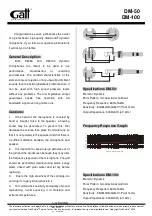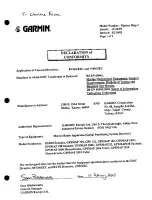
19
TIPS
• For operation with external antenna, low loss RF shielded cable should be
used and the length of the cable should not exceed 3m.
• Do not place the receive antenna within 1 meter of another receiver or
antenna.
• The receiver antenna should be kept away from any metal surface.
• If the Volume Control of the receiver is set too high, it may over-drive the input
of the mixer, causing distortion. Conversely, if the receiver output is set too
low, the overall signal to noise ratio of the system may be reduced. Adjust the
output level of the receiver such that highest sound pressure level going into
the microphone causes no input overload in the mixer, and yet permits the
mixer level controls to operate in their normal range (not too high or too low).
This provides the optimum signal to noise for the entire system.
• Before inserting the batteries, please make sure that they are inserted
according to the correct polarity.
• For PLL frequencies agile version, before operation please make sure that the
corresponding receiver MUST have the same frequency group and channel
number as the transmitter.
• After making a channel change, please make sure that the corresponding
change is made on the matching receiver also. To be exact, changes MUST be
made at both the transmitter and receiver.
• Use only brand new Alkaline batteries. Do not use “general purpose “
batteries. When batteries are weak, replace the batteries altogether at the
same time. Do not mix and use new and old batteries together.
• Position the receiver such that it has the least possible obstructions between it
and the transmitter. Line of sight is best!
• The transmitter and the receiver should be as close as possible but not less
than 1 meter.
• A receiver cannot receive signals from two or more transmitters
simultaneously.
• Turn the transmitter off when it is not in use. Remove the batteries if it is not to
be used for a period of time.
(Note: Scratchy noises can sometimes occur when some electric guitars with
dirty pots or connections are used with any wireless system. Therefore, the
supplied INSTRUMENT CORD has a factory installed capacitor inside the 1/4”
plug. This capacitor provides first order filtering of the RF signal from the cord
into the guitar and eliminates virtually all scratchy noises. Should your
equipment still give you scratchy noises, we suggest these steps to eliminate
them:
1) Make sure all guitar volume and tone pots are clean and all contacts are
solid-this is very important.
2) A 47pf capacitor soldered across the hot to ground terminals of the guitar’s
volume and tone pots will provide extra filtering.)
next location. After finishing the edit hold the SET (7) button until the curser
stops blinking.
4. Group and Channel (Preset)
Choose the UHF-1000 operating frequency by
selecting one of the 24 Groups and one of the 40
Channels in each group. The first two top digits on
the left are the Group and the second top two
digits to the right are the Channel.
In the Group and Channel Menu, hold the SET (7) button for 3 seconds.
The curser will blink in the Group selection and the frequency is displayed, use
UP (4) or DOWN (5) buttons to cycle the Group selection. Press SET (7), the
curser will advance to the Channel selection, press the UP (4) or DOWN (5)
buttons to cycle the selections. After finishing the edit hold the SET (7) button
until the curser stops blinking.
5. User Edit
The user edit memory stores 40 selections of
channel frequencies. If the frequencies are not
between 721.000-745.975 MHz for Band-1 or
795.000-819.975 MHz for Band-2 they will not be saved.
In the User Edit Menu, hold the SET (7) button for 3 seconds.
The curser will blink and the memory location and frequency are displayed,
press the UP (4) or DOWN (5) buttons to cycle the memory locations. Press the
SET (7) button, the curser will blink in the frequency, press the SET (7) button to
cycle the frequency digits. Press the UP (4) or DOWN (5) buttons to cycle the
frequency assignment. After finishing the edit hold the SET (7) button until the
curser stops blinking, the User Name menu will appear.
6. Channel Frequency
Choose an operating frequency by selecting the
Channel and Group. Same as above Group and
Channel menu, except it displays the Carrier
frequency.
7. Squelch Level
There are eight choices between -100 and -65
dBm. In the Squelch Level Menu, hold the SET (7)
button for 3 seconds. The curser will blink in the
Squelch Level selection, use the UP (4) or DOWN
(5) buttons to cycle the selections. After finishing the edit hold the SET (7)
button until the curser stops blinking.
The RF and AF level meters, diversity operation, and audio output connections
of the receiver are described in the System Operation section (pgs 16,17).
6
OPERATING INSTRUCTIONS
CF: 01 - 01
RF AF
721.000 MHz
RF AF
SQUELCH LEVEL
-100 dBm (1)
USER EDIT: - 01
RF AF
U-1000, U-2000 Receiver






























